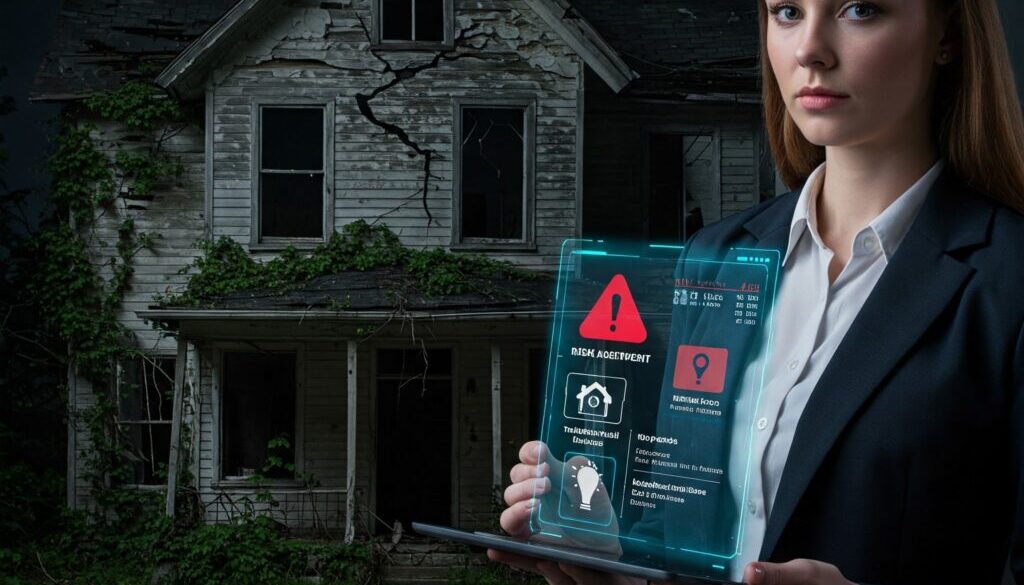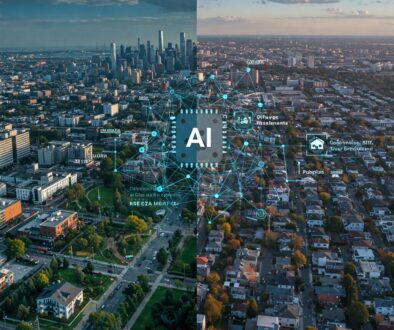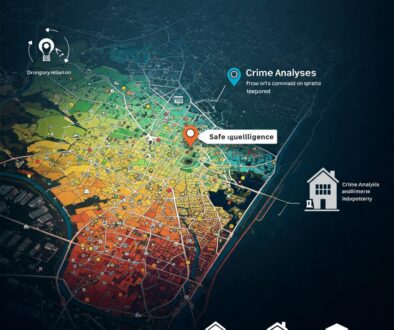Risk Assessment in Real Estate: How AI Identifies Red Flags Before Purchase
Risk assessment in real estate has traditionally relied heavily on experience, intuition, and limited due diligence processes. Investors and developers typically focus on obvious risks visible in standard inspections, basic financial analysis, and general market research. While this approach identifies many common issues, it frequently misses subtle but significant risk factors that can dramatically impact investment outcomes.
In 2025, AI-powered geospatial intelligence platforms like Locas.dev are revolutionizing real estate risk assessment, utilizing sophisticated algorithms to analyze thousands of data points and identify potential problems that traditional methods often overlook. This enhanced risk intelligence not only helps investors avoid costly mistakes but also provides negotiation leverage and informs risk mitigation strategies.
The Evolution of Real Estate Risk Assessment
Traditional Approach
Conventional risk assessment in real estate typically involves:
- Physical inspections identifying visible issues
- Title searches revealing recorded encumbrances
- Environmental Phase I assessments for obvious contamination
- Basic financial analysis with standard assumptions
- General market research on broad trends
While valuable, this approach has significant limitations:
- Heavily dependent on inspector quality and thoroughness
- Limited to visible or documented issues
- Focused primarily on the property rather than its context
- Minimal forward-looking risk analysis
- Insufficient integration of diverse risk factors
“Traditional risk assessment is essentially a checklist approach,” explains risk management consultant Dr. Emma Chen. “It’s good at finding common, obvious issues but systematically misses subtle indicators and interconnected risk factors that might be the most significant threats to investment performance.”
How AI Transforms Real Estate Risk Assessment
Modern geospatial intelligence platforms transform risk identification through:
1. Environmental Risk Pattern Recognition
Traditional Approach: Standard Phase I environmental assessments focus primarily on documented contamination and visible evidence, often missing subtle indicators of potential issues.
AI-Enhanced Approach: Sophisticated environmental risk intelligence includes:
- Historical land use pattern analysis identifying undocumented contamination risk
- Soil and groundwater vulnerability modeling based on geology and historical activities
- Environmental regulation trajectory prediction for future compliance requirements
- Climate change impact projection on specific properties
- Natural hazard vulnerability assessment beyond basic flood zone designation
Real-World Impact: “Our AI platform identified unusual vegetation patterns in historical aerial imagery that suggested potential soil contamination not flagged in the Phase I report,” notes Michael Rodriguez of Summit Investments. “Targeted testing confirmed industrial solvent presence from an undocumented business that operated on the site in the 1970s. This discovery before purchase allowed us to negotiate a $1.2 million price reduction and secure seller remediation responsibility—saving us from a significant post-acquisition liability.”
2. Infrastructure Vulnerability Detection
Traditional Approach: Basic verification of utility connections with limited assessment of infrastructure age, condition, or future adequacy.
AI-Enhanced Approach: Comprehensive infrastructure risk analysis includes:
- Infrastructure age and deterioration prediction modeling
- Capacity constraint identification for various utilities
- Capital improvement requirement forecasting
- Special assessment likelihood analysis for infrastructure upgrades
- Utility rate increase vulnerability based on system conditions
Real-World Impact: A developer evaluating a suburban residential site received clean traditional due diligence reports showing adequate water and sewer connections. However, AI-powered infrastructure analysis identified that the water system serving the property was at 93% of capacity with deteriorating main lines that would require replacement within 3-5 years. This intelligence allowed them to negotiate infrastructure contribution limits in their purchase agreement, protecting against a potential $2.3 million unexpected cost when the municipality subsequently required new development to fund system upgrades.
3. Regulatory Risk Forecasting
Traditional Approach: Basic confirmation of current zoning and entitlements with limited ability to predict future regulatory changes that might affect the property.
AI-Enhanced Approach: Sophisticated regulatory intelligence includes:
- Regulatory change pattern recognition across jurisdictions
- Policy evolution trajectory analysis for specific locations
- Political shift impact assessment on development regulations
- Compliance requirement forecasting for building standards
- Entitlement risk evaluation for approval processes
Real-World Impact: “The AI analysis identified a strong pattern of increasing affordable housing requirements in jurisdictions with similar political and housing market characteristics to our target area,” explains Jennifer Wu of Urban Development Partners. “While no such policy had been formally proposed yet, the system predicted an 82% probability of inclusionary housing requirements being adopted within 24 months. We restructured our development approach to proactively incorporate affordable components, which ultimately facilitated faster approvals and protected us from more stringent requirements that were indeed enacted 18 months later.”
4. Market Vulnerability Assessment
Traditional Approach: General market analysis based on current conditions and recent trends, with limited ability to identify specific vulnerabilities or project downside scenarios accurately.
AI-Enhanced Approach: Detailed market risk intelligence includes:
- Demand driver fragility assessment for specific locations
- Oversupply risk identification from pipeline analysis
- Tenant industry vulnerability evaluation
- Economic shock sensitivity modeling
- Competitive positioning risk analysis
Real-World Impact: An investor was considering two seemingly similar office buildings in different submarkets. Traditional analysis showed comparable current performance and general market conditions. However, AI-powered vulnerability assessment revealed one property had 68% of tenants in industries highly vulnerable to automation and remote work trends, while the other had a more resilient tenant base. This intelligence led to the selection of the lower-risk property, which subsequently maintained strong performance during a market disruption that significantly impacted the rejected property.
5. Hidden Physical Risk Identification
Traditional Approach: Standard property inspections that identify visible issues but often miss latent problems, especially those requiring specialized knowledge or historical context.
AI-Enhanced Approach: Advanced physical risk detection includes:
- Building system failure probability modeling based on age and type
- Construction method risk identification for specific era buildings
- Material vulnerability analysis for problematic components
- Design flaw pattern recognition from similar structures
- Maintenance history gap identification
Real-World Impact: “The AI system flagged a statistically high risk of plumbing system failures in a multifamily building constructed between 1995-1998 in this specific region,” notes David Chen of Horizon Acquisitions. “This wasn’t visible in standard inspections, but further investigation revealed polybutylene piping throughout the building—a failure-prone material used during that period. This discovery allowed us to negotiate a $750,000 price adjustment to cover eventual replacement costs, addressing a significant risk that conventional due diligence had missed entirely.”
Case Study: The Westridge Commercial Center
When Meridian Investments was evaluating a retail center acquisition, they employed both traditional due diligence and AI-powered risk assessment:
Traditional Due Diligence Results:
- Clean Phase I environmental report
- Satisfactory property condition assessment
- Clear title with standard easements
- Solid current financial performance
- Stable recent market conditions
- No immediate capital requirements identified
AI-Enhanced Risk Assessment Findings:
- 42% of tenants in retail categories with high e-commerce vulnerability
- Substantial probability of drainage infrastructure inadequacy during increasing storm intensity
- Statistical pattern suggesting undisclosed roof issues based on construction era and maintenance records
- Zoning change pattern in similar corridors indicating 67% probability of traffic pattern modifications
- Anchor tenant financial analysis showing concerning trends not visible in standard credit reports
Based on this comprehensive risk intelligence, Meridian:
- Restructured their offer to include specific representations and warranties
- Commissioned targeted investigations of the identified risk areas
- Modified their financial projections to account for tenant vulnerability
- Developed contingency plans for potential regulatory changes
- Created a phased capital improvement strategy addressing hidden infrastructure issues
The result was a transaction with significantly improved risk-adjusted returns. Within 18 months, three of the five risks identified by the AI had materialized, but Meridian’s proactive approach based on early warning allowed them to mitigate these challenges effectively, maintaining projected returns while competitors with similar properties faced unexpected costs and performance shortfalls.
Key Risk Categories for Comprehensive Assessment
Modern geospatial intelligence platforms analyze several critical risk dimensions to provide complete property risk profiles:
1. Physical and Environmental Risks
- Structural vulnerability factors based on building characteristics
- Material failure probabilities for specific components
- Environmental contamination likelihood from historical uses
- Natural hazard exposure across multiple threat types
- Climate change vulnerability specific to property location
2. Market and Financial Risks
- Demand fragility assessment for property type and location
- Supply pipeline impact on market equilibrium
- Tenant/buyer profile vulnerability
- Revenue stream stability analysis
- Exit strategy risk evaluation
3. Regulatory and Compliance Risks
- Zoning change probability based on policy patterns
- Building code evolution impacts on future requirements
- Environmental regulation trajectory affecting operations
- Infrastructure contribution risk from public funding gaps
- Entitlement process vulnerability for development projects
4. Operational and Expense Risks
- Utility cost increase projections
- Maintenance requirement forecasting
- Insurance premium trajectory modeling
- Property tax reassessment risk
- Service disruption vulnerability
5. Strategic and Opportunity Risks
- Competitive positioning vulnerability
- Technological disruption exposure
- Demographic shift impacts
- Adaptability constraint identification
- Highest and best use evolution risk
Implementing AI-Powered Risk Assessment in Your Investment Strategy
To leverage these advanced capabilities in your real estate risk management approach:
1. Adopt a Multi-Dimensional Risk Framework
Move beyond simplistic risk assessment approaches:
- Evaluate properties across multiple risk categories simultaneously
- Consider interrelationships between different risk factors
- Assess both immediate and emerging risks
- Balance property-specific and location-based risk factors
- Incorporate forward-looking risk projections
2. Apply Risk Insights Throughout the Investment Process
Use risk intelligence at every stage:
- Pre-acquisition screening to eliminate high-risk properties early
- Due diligence targeting to focus investigations on identified risks
- Offer structuring with risk-mitigating terms
- Valuation adjustment for quantified risk factors
- Post-acquisition management planning addressing identified vulnerabilities
3. Develop Risk-Adjusted Decision Making
Create a systematic approach to incorporating risk in investment decisions:
- Quantify risk factors in financial terms where possible
- Develop probability-weighted scenarios for different risk outcomes
- Calculate risk-adjusted returns across investment alternatives
- Establish risk tolerance thresholds for different investment categories
- Create portfolio-level risk balancing strategies
4. Implement Strategic Risk Mitigation
Use risk intelligence to develop proactive mitigation approaches:
- Design targeted risk reduction strategies for identified issues
- Allocate capital to highest-priority risk mitigation efforts
- Structure partnerships and insurance to transfer appropriate risks
- Create contingency plans for high-impact potential events
- Develop regulatory engagement strategies for compliance risks
5. Monitor Evolving Risk Landscapes
Recognize that risk profiles change over time:
- Implement continuous risk monitoring systems
- Track early warning indicators for emerging threats
- Regularly reassess property vulnerability as conditions change
- Update risk mitigation strategies based on evolving factors
- Adjust hold/sell decisions as risk landscapes transform
The Future of AI in Real Estate Risk Assessment
As AI and geospatial intelligence continue to evolve, several emerging capabilities promise even more sophisticated risk identification:
Real-Time Risk Monitoring
Future systems will continuously track risk indicators, providing instant alerts when new information or changing conditions affect property risk profiles.
Personalized Risk Evaluation
Advanced platforms will calibrate risk assessments to your specific investment strategy, operational capabilities, and risk tolerance, highlighting the factors most relevant to your situation.
Integrated Risk-Opportunity Analysis
AI will increasingly identify how specific risks might be transformed into opportunities through strategic approaches, recognizing where risk mitigation can create competitive advantage.
Scenario-Based Risk Simulation
Future intelligence will model how properties might perform under various risk scenarios, allowing more sophisticated contingency planning and strategic optionality.
Collaborative Risk Intelligence
Platforms will enable anonymized risk pattern sharing across investor networks, creating more comprehensive risk identification while maintaining individual competitive advantages.
Conclusion: From Risk Avoidance to Strategic Advantage
Comprehensive risk assessment represents not just a defensive necessity but a strategic opportunity in real estate investment. The evolution from basic checklist approaches to sophisticated AI-powered risk intelligence allows investors to:
- Identify hidden risks before they impact performance
- Quantify risk factors for more accurate valuation
- Negotiate better terms based on specific risk insights
- Develop targeted mitigation strategies for identified vulnerabilities
- Create competitive advantage through superior risk management
In an increasingly complex and dynamic market environment, the ability to identify and manage risk effectively becomes a key differentiator between average and exceptional investment performance.
Ready to transform your approach to real estate risk assessment? Try Locas.dev today and experience the power of AI-driven risk intelligence for your next investment.
This article reflects the current state of AI technology in real estate risk assessment. For the latest updates and features, visit Locas.dev.
Keywords: real estate risk assessment, property investment risk, AI risk detection, real estate due diligence, property risk analysis, investment risk identification, real estate risk management



